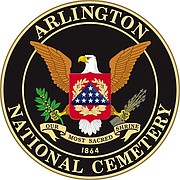THE VETERANS' PRESS: Inside and underneath Arlington National Cemetery
It’s about 3 p.m. on Memorial Day at Arlington National Cemetery. When burials are finished for the day, trucks bring out big wooden crates and drop them off at various stations. The crates are full of small flags — more than 270,000 — the wooden sticks still muddy from last year. The flags have a sharp point on top and are pushed into the ground by hand, about a foot away from the front of each headstone.
Members of the 3rd U.S. Infantry, the Old Guard, conduct this somber all-day operation.
Now it’s about 6 p.m. An officer hears the faint notes of a bugle and calls his company to attention.
Taps is being played as part of a wreath laying ceremony at the Tomb of the Unknowns. The soldiers stand at attention in respect. This is hallowed ground. This is 624 acres of the most famous of all American military cemeteries.
The Old Guard completes their mission. They will return the following day to retrieve the flags and put them into storage for next year.
Arlington National Cemetery, on a hilltop overlooking the Potomac River and Washington, D.C., is built on plantation land that once belonged to George Washington Parke Custis, grandson of Martha Washington and step-grandson of President George Washington. Custis, at the age of 21, inherited the 1,100-acre plantation from his father in 1802. He built Custis Mansion, now known as Arlington House, a Greek Revival-style mansion on the property as a tribute to George Washington, and filled the home with many of Washington’s belongings.
In 1857, Custis willed the property to his daughter, Mary Anna. Mary became the wife of Robert E. Lee, then a military officer in the U.S. Army. Lee took command of the Confederate Army of Northern Virginia at the onset of the Civil War in 1861, and vacated the property that spring as Union troops advanced into the Virginia hills outside Washington. The Union Army used the land and house as a camp and headquarters. In 1864, when Mary Anna, confined to a wheelchair, sent a representative to pay a $92.07 tax bill (instead of appearing personally), the government seized the property. With the Civil War entering its third year, fatalities began to outpace burial capacity in area cemeteries. To address the problem, Arlington was designated a national military cemetery.
Private William Christman of Pennsylvania was the first military service member to be buried at Arlington on May 13, 1864. Christman was a farmer, newly recruited into the Army. He fell ill with the measles and died several days later of complications before ever going into combat. Approximately 16,000 Civil War soldiers are buried at Arlington National Cemetery. More than 420,000 people have been buried at Arlington National Cemetery. Arlington is the only national cemetery to hold service members from every war in U.S. history. The most visited areas in the cemetery are the gravesite and eternal flame of President John F. Kennedy, and the Tomb of the Unknown Soldier, which celebrates its centennial this year. More than three million people visit Arlington National Cemetery annually.
An average of 25 U.S. service members or relatives are buried at Arlington each day. The cemetery, which has gone through several expansions through the years, now spans roughly one square mile. The Millennium Expansion Project, started in 2014, added 27 acres and roughly 30,000 additional burial plots to the cemetery. This expansion, the first of the cemetery space in nearly 40 years, cost around $81.7 million. Even with the expansion, Arlington National Cemetery is expected to reach capacity by the 2040s.
Information on eligibility for burial in Arlington National Cemetery can be found at www.arlingtoncemetery.net/eligb.htm. For information regarding the Tomb centennial celebration, go to www.tombguard.org/news/centennial.



